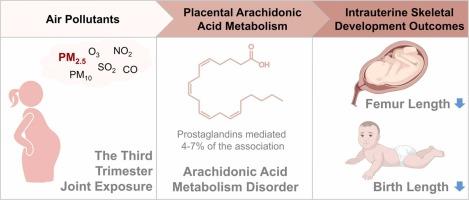妊娠期联合暴露于空气污染物与宫内骨骼发育:中国出生队列中胎盘代谢组的中介作用
IF 11.3
1区 环境科学与生态学
Q1 ENGINEERING, ENVIRONMENTAL
引用次数: 0
摘要
来自流行病学和毒理学的证据表明,怀孕期间暴露于单独的空气污染物会损害宫内骨骼发育,但污染物混合物和介导的生物途径的共同影响尚不清楚。在一项包含470对母婴的中国出生队列中,我们研究了联合暴露于六种常见空气污染物(细颗粒物和可吸入颗粒物、二氧化氮、二氧化硫、一氧化碳和臭氧)与宫内骨骼发育标志物(宫内股骨长度和出生长度)之间的关系。我们进一步探讨了胎盘代谢物在这些观察到的关联中的潜在介导作用。我们的研究结果表明,妊娠晚期关节暴露于空气污染物与子宫内股骨长度和出生长度呈负相关,其中PM2.5是主要因素。具体来说,混合物中每增加五分位数与股骨长度(β = -0.08 SD; 95% CI: -0.16, -0.01)和出生长度(β = -0.11 SD; 95% CI: -0.19, -0.03)的减少有关。胎盘代谢组学分析发现,花生四烯酸代谢与空气污染物和宫内骨骼发育都有显著联系。具体而言,花生四烯酸代谢组学评分与关节暴露于空气污染物呈正相关,但与出生长度负相关。前列腺素,包括前列腺素E2和前列腺素F2α介导4.16-7.24%的负相关。我们的研究结果表明,孕妇妊娠晚期关节暴露于空气污染物可能会通过破坏胎盘花生四烯酸代谢而对宫内骨骼生长产生不利影响。本文章由计算机程序翻译,如有差异,请以英文原文为准。

Gestational joint exposure to air pollutants and intrauterine skeletal development: Mediating effect of placental metabolome in a Chinese birth cohort
Evidence from both epidemiology and toxicology suggests that exposure to individual air pollutant during pregnancy can impair intrauterine skeletal development, but the joint effects of pollutant mixtures and the mediating biological pathways are poorly understood. Within a Chinese birth cohort comprising 470 mother-infant pairs, we investigated the associations between joint exposure to six common air pollutants (fine particulate matter and inhalable particulate matter, nitrogen dioxide, sulfur dioxide, carbon monoxide, and ozone) and markers of intrauterine skeletal development (intrauterine femur length and birth length). We further explored the potential mediating role of placental metabolites in these observed associations. Our results show that joint exposure to air pollutants during the third trimester was inversely associated with femur length in utero and birth length, in which PM2.5 was the primary contributor. Specifically, each quintile increase in the mixture was linked to decreases in femur length (β = −0.08 SD; 95 % CI: −0.16, −0.01) and birth length (β = −0.11 SD; 95 % CI: −0.19, −0.03). Placental metabolomic analysis identified that arachidonic acid metabolism was significantly linked to both air pollutants and intrauterine skeletal development. Specifically, arachidonic acid-metabolomic score was positively associated with joint exposure to air pollutants but negatively associated with birth length. Prostaglandins, including prostaglandin E2 and prostaglandin F2α mediated 4.16–7.24 % of the observed inverse associations. Our findings suggest that maternal third trimester joint exposure to air pollutants may adversely affect intrauterine skeletal growth, potentially through disrupting placental arachidonic acid metabolism.
求助全文
通过发布文献求助,成功后即可免费获取论文全文。
去求助
来源期刊

Journal of Hazardous Materials
工程技术-工程:环境
CiteScore
25.40
自引率
5.90%
发文量
3059
审稿时长
58 days
期刊介绍:
The Journal of Hazardous Materials serves as a global platform for promoting cutting-edge research in the field of Environmental Science and Engineering. Our publication features a wide range of articles, including full-length research papers, review articles, and perspectives, with the aim of enhancing our understanding of the dangers and risks associated with various materials concerning public health and the environment. It is important to note that the term "environmental contaminants" refers specifically to substances that pose hazardous effects through contamination, while excluding those that do not have such impacts on the environment or human health. Moreover, we emphasize the distinction between wastes and hazardous materials in order to provide further clarity on the scope of the journal. We have a keen interest in exploring specific compounds and microbial agents that have adverse effects on the environment.
 求助内容:
求助内容: 应助结果提醒方式:
应助结果提醒方式:


